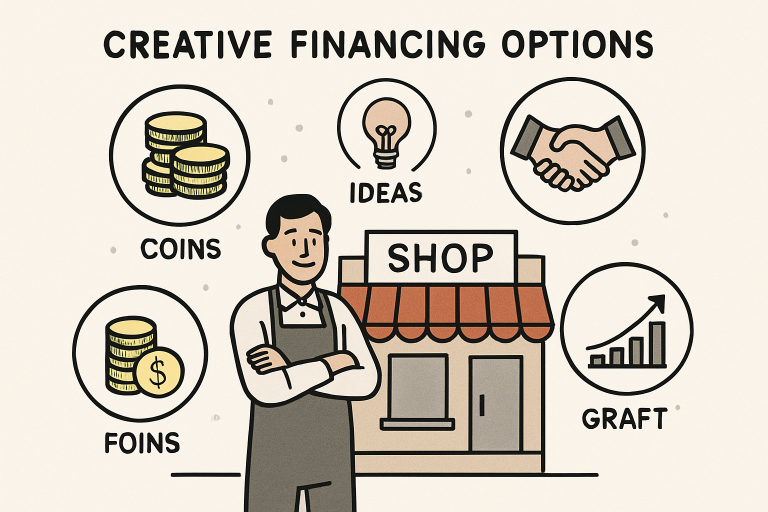Key Takeaways
- Explore alternative financing options beyond traditional bank loans.
- Understand the benefits and considerations of each financing method.
- Leverage technology and community resources to enhance funding opportunities.
Table of Contents
- Revenue-Based Financing
- Invoice Financing
- Crowdfunding
- Peer-to-Peer Lending
- Merchant Cash Advances
- Microloans
- Net 30 Vendor Accounts
- Leveraging Technology for Financing
Small businesses often face significant challenges when acquiring capital to foster growth and innovation. Traditional bank loans can be challenging to qualify for, especially for newer ventures or those with limited assets. As a result, entrepreneurs increasingly turn to unconventional funding methods to keep their businesses moving forward. Exploring options like revenue-based financing, invoice financing, and crowdfunding can open new doors for companies that traditional lenders might otherwise overlook. For business owners seeking the best small business financing in Sapulpa, understanding these creative financing methods can be crucial to navigating today’s fast-moving marketplace.
By embracing alternative funding solutions, small businesses can often access capital more quickly and on more flexible terms than banks typically offer. Strategies like peer-to-peer lending and microloans provide vital financial resources and help companies develop a track record of successful repayment and economic stewardship. Leveraging these innovative financial products allows businesses of all sizes to adapt, compete, and ultimately thrive without sacrificing future stability.
Securing capital creatively and appropriately can mean the difference between being able to invest when opportunity knocks or struggling to keep the lights on during leaner times. Alternative financing options frequently offer tailored solutions to meet the needs of specific industries, business models, or cash flow cycles. Ultimately, carefully chosen creative financing remedies can pave the way for future growth, long-term resilience, and a more robust business ecosystem.
Revenue-Based Financing
Revenue-based financing (RBF) is an increasingly popular solution for small businesses with strong revenue prospects that find it challenging to secure traditional funding. With RBF, investors provide capital in exchange for a predetermined percentage of ongoing business revenues, resulting in repayment amounts that rise and fall with business income. This level of adaptability is especially beneficial for companies experiencing seasonal shifts or irregular sales cycles. According to Forbes, RBF’s flexibility makes it a practical choice for businesses eager to preserve ownership without taking on fixed debt obligations.
Invoice Financing
Invoice financing helps businesses bridge the gap between issuing invoices and receiving payment. By allowing companies to borrow against the value of unpaid invoices, this option provides immediate liquidity to cover payroll, operating expenses, or inventory purchases. The method is beneficial for B2B firms or those working with clients that have long payment terms. As noted by Inc.com, invoice financing can also reduce the risks associated with cash flow shortages, although business owners should evaluate potential costs and provider terms before committing.
Crowdfunding
Crowdfunding platforms like Kickstarter and Indiegogo allow businesses to raise capital from a broad base of supporters, often in exchange for perks, pre-orders, or branded merchandise. This approach raises necessary funds and acts as a marketing tool and a way to validate a product or service concept before scaling operations. While a successful campaign may boost brand exposure and provide a loyal initial customer base, it requires careful planning, a compelling pitch, and strong promotion efforts to achieve funding goals.
Peer-to-Peer Lending
Peer-to-peer (P2P) lending sidesteps traditional banks by connecting business borrowers with individual or institutional lenders through online platforms. Frequently, the approval requirements are less stringent, making this option accessible to newer or credit-challenged businesses. Borrowers may also benefit from competitive rates and more transparent terms. However, as with other loan products, it’s essential to thoroughly vet platforms and understand all costs involved to avoid unforeseen expenses or obligations.
Merchant Cash Advances
Merchant cash advances (MCAs) allow businesses with steady credit or debit card sales to access capital rapidly. With an MCA, a provider advances funds and recoups repayment as a portion of future sales. While MCAs are known for fast funding and high approval rates, they often carry higher effective interest rates than most loans. Business owners should review the total payback amount and repayment terms to ensure the advance does not restrict cash flow or operational flexibility.

Microloans
Microloans are small, typically short-term loans provided by organizations such as the SBA or nonprofit lenders to serve startups or small businesses lacking extensive credit history. These funds might be used for everything from equipment purchases to working capital, and often come with technical assistance or mentoring programs. Microloans remain a critical entry point for underserved entrepreneurs, fueling growth and supporting economic diversity at the community level.
Net 30 Vendor Accounts
Net 30 vendor accounts enable businesses to obtain goods or services and pay for them within 30 days. These arrangements build essential business credit, simplify inventory management, and ease short-term cash flow constraints by spacing out major purchases. Timely repayment on these accounts is crucial, as it can improve future access to capital and strengthen business relationships with key suppliers.
Leveraging Technology for Financing
Technological innovations are reshaping how small businesses secure financing. Technology is breaking down many barriers that previously prevented entrepreneurial growth, from AI-powered lending platforms that enhance application approval efficiency to software that optimizes crowdfunding campaigns for higher success rates. Fintech solutions can offer custom loan recommendations, automate underwriting, and ensure businesses are matched with funding programs suited to their specific financial situations. Embracing digital tools streamlines financing and often provides data-driven insights that can guide strategic business decisions.
Choosing the right creative financing solution is key to long-term success. Understanding your options and the fine print behind each can help you harness the capital and flexibility needed to fuel your small business ambitions.
